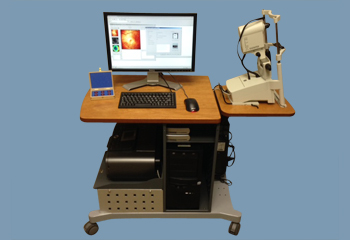
The Heidelberg HRT III Tomographer is a proven, essential tool for detecting and managing glaucoma, especially for assisting in the identification of pre-perimetric disease and tracking progression. The Ancillary Study to the Ocular Hypertension Treatment Study (OHTS) demonstrated that optic disc analysis detected glaucoma conversion in 55% of cases, before any detectable loss of visual function. The Heidelberg HRT III has proved to be a robust predictor of glaucoma. OHTS also concluded that the Heidelberg HRT III recognized temporal superior defects which later developed into confirmed glaucoma in 40% of cases, looking only at baseline measurements, and then confirmed the diagnosis with an average of 5 years of follow up. Equally impressive was that 93% of all Heidelberg HRT III cases flagged as within normal limits at baseline remained within normal limits during the same time period.
The recent discovery of hidden artifacts within time-domain OCT scans may explain why time-domain OCT performed so poorly in a separate, but similar study, where baseline predictive values for corneal thickness outperformed OCT with an average of 5 years of follow-up.
One explanation for the difference in glaucoma predictive power is the incredible can speed of the Heidelberg HRT III. Single tomographic slices are captured in just 24 milliseconds (compared to the fastest time of the domain OCT slices captured at 368 milliseconds). Since constant involuntary eye movements occur within 30 – 50 milliseconds, and larger movements due to fixation problems can be 150 milliseconds or greater, time-domain OCT may be highly susceptible to motion artifact.
The Heidelberg HRT III combines the advantage of speed with the power of Heidelberg Engineering’s TruTrack image alignment software to deliver unmatched performance and clinical utility. TruTrack works in the background, tracking over 500 points on each image, enabling follow up scans to be precisely aligned to baseline for detecting small changes reliably.
Features:
• A Powerful Predictor of Change
• Validated by OHTS to predict structural change
• Progression analysis validated with 10 years of patient data
• Optic disc analysis outperforms expert interpretation
• Large, ethnic-selectable databases
• Asymmetry analysis
• Upgradeable platform
• Network ready












